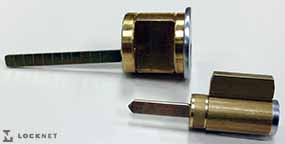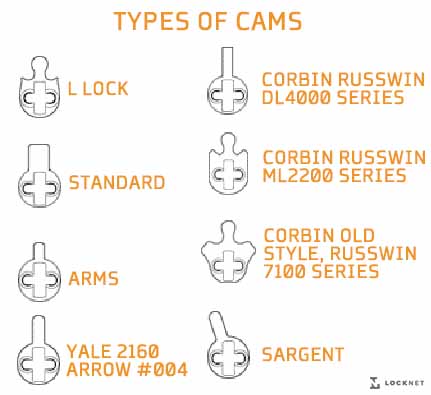A few weeks ago, I reviewed the different types of cylinders; I thought it would be fitting to move on to the mechanics a cylinder uses to operate a device – the cam or tailpiece. Cams and tailpieces attach to the back of the cylinder. When the key is turned, it rotates the cam or tailpiece, actuating the function of the device (locks/unlocks the device, turns it on/off).
If a picture is worth a thousand words, a video is worth a million. Check out this high-tech production of a lock’s inner workings.
Tailpieces
Tailpieces are used in rim cylinders and key in knob/lever cylinders. They vary in shape and length depending on the brand and type of lock into which the cylinder is installed.
For example, the tailpiece for a rim cylinder is long as it needs to extend through the width of the door; whereas, the tailpiece on a key in lever cylinder is short since it only needs to extend through the handle.
Similarly, the tailpiece on a Dorma key in lever cylinder will likely have a different shape than that of a Yale key in lever cylinder. There are a plethora of tailpiece lengths and shapes in today’s market; I would love to show you pictures of them all, but that would be quite an expansive image. Suffice it to say they resemble some variant of these.
Cams
 Cams are used in most any other type of cylinder. They are flat pieces that attach to the back of the cylinder, and each type of cam is shaped differently. Much like tailpieces, the type of cam needed is determined by the brand of lock. A Corbin Russwin cam will not work in a Yale device and vice versa. This is because the shape of the cam would not properly align with the inner-workings of the lock.
Cams are used in most any other type of cylinder. They are flat pieces that attach to the back of the cylinder, and each type of cam is shaped differently. Much like tailpieces, the type of cam needed is determined by the brand of lock. A Corbin Russwin cam will not work in a Yale device and vice versa. This is because the shape of the cam would not properly align with the inner-workings of the lock.
For example, if the end of the cam is too short, it won’t catch the lock. If it’s too long, it may not be able to turn. Much like tailpieces, the list of available cams is quite large. Here are the most common cams available in today’s market.
That’s it; you are now armed with the information you need to strike up a fascinating conversation at next weekend’s tailgate. Ok – it may not be that exciting, but it’s pretty interesting nonetheless. Have any questions? Did we leave anything out? Let us know in the comments!
Google
Google


